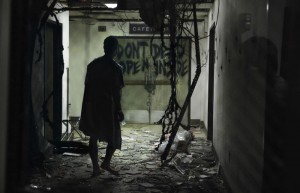As Halloween winds down, new frights hit TV
If you weren’t partying, trick-or-treating or otherwise gallivanting at 10 p.m. on Halloween night, chances are the television was on. And for 5.3 million people, AMC was the channel to watch.

Dead or alive · As with the comic series, The Walking Dead details Rick Grimes’ (Andrew Lincoln) attempts to survive a zombie outbreak. - Photos courtesy of AMC
The cable television channel took on the richly detailed, psychologically probing series The Walking Dead. Bringing to life the characters of Robert Kirkman’s comic series of the same name, the show revolves around the aftermath of a zombie outbreak. The pilot was an episode that would appeal to comic book and Halloween lovers alike, balancing a faithful account of the comic book with the right amount of zombie facetime.
But the series expands beyond that. Since Kirkman’s first issue back in 2003, the tone of the story was clear. Kirkman’s intent is not to spook people in cliché Halloween fashion but instead to dig deeper into the idea of someone being trapped in a world chock-full of zombies.
“This book is more about watching [protagonist Rick Grimes] survive than it is about watching zombies pop around the corner and scare you,” Kirkman explained in the introduction to Days Gone Bye, the first volume in the series and aptly the title of the first episode.
The psychological thrill carries over very well in the show’s first episode. Adapted to the screen by director Frank Darabont (The Shawshank Redemption), the television series takes the liberty of including material not in the original work.
The pilot starts off with Grimes (Andrew Lincoln), the lone sheriff deputy of a petite Southern town who wakes from a coma to find the world has gone to hell. The opening scene finds him wandering amid abandoned vehicles. As he crouches to look underneath a car, the camera begins to control and experiment with point of view in classic horror film fashion.
Here the audience has tunnel vision as two skinny legs, with the feet in a pair of filthy bunny slippers, slowly move within Grimes’ view. A pale hand reaches down and grasps a white plush bunny lying alone on the bare ground. Grimes tries to help what he thinks is a little girl but instead encounters a zombie, her face bloody and distorted, and kills her with one clean shot to the head.
The flashback creates a different mood in the beginning of the story, though one that remains true to the original intent. The Walking Dead follows the events in Grimes’ story in strictly chronological order, beginning with the car chase that lands him in a deep coma.
In doing so, the series maintains the comic’s tone while avoiding a strict reproduction of scenes. Here, the audience immediately realizes the sad reality that the disease spared no victims and that Grimes had no choice but to shoot the girl.
This technique is echoed later in the episode, the most important display seen in the inclusion of a female zombie that never existed in the series — the wife and mother of the Jones family.
Here, the audience watches the heart-wrenching struggle of father Morgan Jones and his young son Duane as the woman they love transforms into a zombie they fear.
Part of the strength of the comic was Kirkman’s ability to make readers stop and wonder what they would do if events similar to the comic happened in real life. Darabont takes this idea further by making the audience question the possibilities of a loved one becoming a zombie.
In general, the camera can take more liberties than comic books to create the effects in which movies and television shows specialize in. Here we get the full effect of the zombie state of being and the makeup artists do an excellent job of recreating illustrator Tony Moore’s hauntingly detailed work in the comic.
The zombies are shown in various states of decay and the bright color of fake blood assails audiences in various scenes, including a lengthy cut of zombies eating a horse as an upbeat song plays paradoxically in the background.
Yet, as with any adaptation, the question is: Will it stay true to the intent of the material, or will the blaring brightness of production lights create an overblown version of an otherwise sound and good story?
In this case, the camera works to the advantage of Kirkman’s vision by embracing the purpose and message of the comic books and also takes the time to do what they cannot.
The lingering images force the viewer to keep his gaze on the face of the suffering zombie, showing the blood spewing from its dead brains in slow motion while its fingers of a zombie slide on barbed wire, and the camera pans out from the street to show the complete infestation of the city Grimes once knew.
For zombie fans, comic book aficionados and those thirsting for more of the Halloween spirit, the show must — and will — go on. The visceral first episode managed to serve as a strong and sincere snapshot of the world Kirkman created in his comic book series.
Though fans of any series might feel hesitant about a television adaptation of a beloved series — past examples have not exactly been great translations, such as Birds of Prey or Smallville — The Walking Dead proves that the right combination of solid acting and attention to the original work’s intent can result in a riveting television show that appeals to original fans and newcomers alike.
The next few Sundays at 10 p.m. will tell whether the series can meet the expectations set by the first episode or will fail to fully capture Grimes’ fantastical journey.
